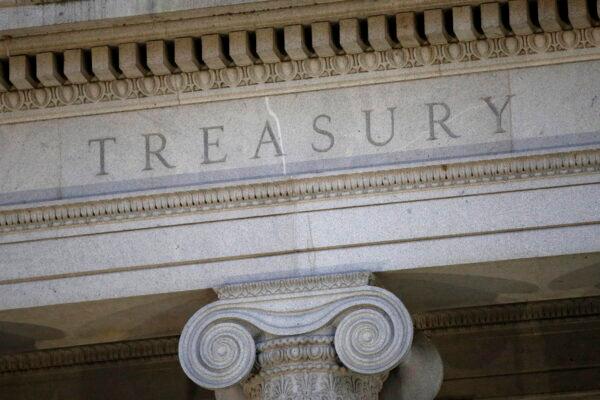The U.S. budget deficit topped $1 trillion in the first six months of fiscal 2024, putting the federal government on track to record its fifth consecutive trillion-dollar-plus shortfall.
According to the Treasury Department, the federal shortfall totaled $236 billion in March, down 38 percent from a deficit of $378 billion in March 2023.
As a result, the fiscal year-to-date budget gap is $1.065 trillion, down $36 billion from the same time last year. The 12-month rolling federal deficit has totaled $1.7 trillion, down $37 billion from the same span last year.
As a share of the economy, the deficit represented 6 percent of the gross domestic product (GDP).
From October to March, tax revenues advanced by 7 percent, to an all-time high of $2.2 trillion. In the same period, expenditures jumped by 3 percent, to $3.2 trillion.
The federal government’s chief spending item has been Social Security, which has risen by roughly 8 percent year over year, to $741.5 billion halfway through fiscal 2024. This has been followed by health ($449 billion) and national defense ($433 billion).
Interest payments have been a considerable expenditure for Washington, ballooning by 36 percent year over year, to $522 billion.
In March, net interest was $79 billion, tied for the third largest outlay and higher than defense spending of $70 billion.
Treasury officials forecast that total interest payments will surpass $1.1 trillion.
This is not sustainable, according to Maya MacGuineas, president of the Committee for a Responsible Federal Budget.
“We’re now halfway through the fiscal year, and today’s numbers from the Treasury remind us how much more work needs to be done,” Ms. MacGuineas said. “Borrowing more than a trillion dollars in just six months can hardly be viewed as sustainable and is much more likely a sign that something is deeply wrong.”
In order to manage the deficit-financed spending at a time of higher borrowing costs, the Treasury plans to issue about $1 trillion in debt securities from January to June. The challenge for the U.S. government has been lackluster demand.
The 10-year note auction on April 10 showed that domestic and foreign investors hesitated to buy government bonds following hotter-than-expected inflation data. The abysmal demand resulted in a 10-year Treasury yield of 4.56 percent.

CBO Numbers
Before the release of the official Treasury data, the Congressional Budget Office (CBO) published the March Monthly Budget Review.The nonpartisan budget watchdog reported that the federal deficit totaled $1.1 trillion in the first half of fiscal 2024, representing a $37 billion decrease from the same time a year ago.
From October to March, revenues climbed by 7 percent year over year and outlays edged up 3 percent.
A notable finding from the CBO’s monthly review was that net interest on the debt totaled $440 billion in the first six months of fiscal 2024, up 43 percent from the same time a year ago. By comparison, U.S. military spending was $412 billion, rising 8 percent year over year from October to March.
Meanwhile, CBO officials have repeatedly pointed out that the budget shortfall would be higher without the various shifts in payment schedules.
“Because April 1, 2023, fell on a weekend, outlays in the first half of fiscal year 2023 were boosted by the shifting of payments into March 2023; those amounts were larger than the amounts shifted from October to September 2022, increasing outlays, on net, in fiscal year 2023,” the CBO noted.
Still, the CBO projects a budget deficit of $1.5 trillion for the current fiscal year, down from $1.7 trillion a year ago.
National Debt Alarm Bells
Scores of prominent individuals have warned about the ramifications of the growing national debt, which recently topped $34.6 trillion.Larry Fink, the CEO of investment-management titan BlackRock, wrote in his annual letter to shareholders that “more leaders should pay attention to America’s snowballing debt.”
“There’s a bad scenario where the American economy starts looking like Japan’s in the late 1990s and early 2000s, when debt exceeded GDP and led to periods of austerity and stagnation,” Mr. Fink said.
Despite his concerns, he said he does not believe a debt crisis is inevitable. He said that the United States needs a blend of tax hikes, spending cuts, and “pro-growth policies.”
According to JPMorgan Chase CEO Jamie Dimon, the United States needs to “maximize economic growth” to grapple with “excess deficit and debt issues.”
“For over two decades, since 2000, America has grown at an anemic rate of 2 percent,” Mr. Dimon recently wrote in his annual shareholder letter. “We should have strived for and achieved 3 percent growth. Had we done so, GDP per person today would be $16,000 higher, which would, in turn, have paid for better health care, childcare, education, and other services.”
Voters have also expressed similar worries surrounding ballooning debt and deficits.
A recent survey by Democratic strategy group Blueprint found that most voters are concerned about these fiscal challenges, including 26 percent who are “extremely concerned.”
“The poll found that voters are currently almost evenly split on whether they have more trust in President Biden or Donald Trump to reduce the deficit,” the group noted.
Under President Joe Biden, the national debt has risen by about $7 trillion. During former President Donald Trump’s term, it climbed by roughly $8.7 trillion.







